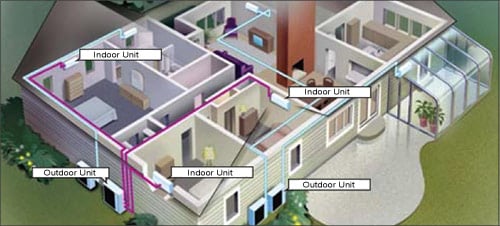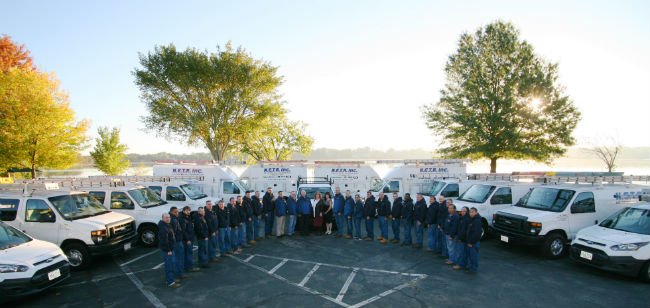Efficient Technology
The tried and true, “smart technology” behind the Ductless Cooling & Heating systems of today has evolved over time. The technology allows energy efficient, individual comfort control with minimal impact on your home as we offer both ductless and limited length ducted solutions.
The technology behind Ductless Cooling & Heating systems is referred to in many different ways, including mini-split, multi-split, split-ductless, split-zoning, and variable refrigerant flow. Split-zoning technology is the primary method for conditioning spaces in homes and commercial buildings around the world.
Split-zoning systems allow each room (or space), using an individual indoor air-handler, to be controlled independently from other rooms, thus providing individualized comfort control within each room of a home.
A Ductless System uses advanced technology to bring you the ultimate in comfort and control while minimizing energy consumption. A Ductless System uses two small refrigerant lines plus power and control wiring to connect an outdoor unit to each individual air handler. This allows for easy installation in new construction and causes minimal disruption if you are renovating or retrofitting your home.
What is a Mr. Slim? How Does It work?
Mr. Slim is a split-ductless air-conditioning system. If you are familiar with a central system, you have the basic idea of what a split system is: an outdoor condensing unit and an indoor evaporator unit.
The basic difference between the two is that with the central system the evaporator unit is typically found in the attic and has ductwork branched off to the different rooms in your house. With Mr. Slim the evaporator is actually in the room being air-conditioned. The indoor unit has a quiet fan that blows across a cold aluminum coil while in the air-conditioning mode. The indoor unit is usually a wall-mounted type, and this unit is connected directly to the outdoor unit by copper tubing and control and power wiring. In the outdoor unit a compressor cycles refrigerant to and from the indoor and outdoor units, and the room air is cooled or heated based on the direction the refrigerant flows between the two.
Detailed Explanation:
Mr. Slim employs the same mechanical components as any basic air-conditioning system whose interactions cause the process of evaporation to occur. Mr. Slim is a split-ductless design, which simply means the indoor unit is separated from the outdoor unit and is connected by a gas and a liquid refrigerant line. The outdoor unit is considered the hot-side during the air-conditioning process. The cold-side unit is located indoors. In the heating process the compressor reverses this operation, and the heat energy is evaporated in the outdoor unit. Then the indoor unit collects this heat energy while a fan blows air over the indoor coil and distributes the warm air into the room.

Air-conditioning Basics:
The process of air-conditioning is dictated by simple physics. Through the evaporation process heat is absorbed by the aluminum fan coil in the indoor evaporator unit and is removed from the room by the gaseous refrigerant. The heated refrigerant (pressured by the compressor) flows into the outdoor unit’s aluminum coils. Here a large fan blows across this coil to discharge the heat energy. The liquid refrigerant is cooled by this process and is cycled back to the indoor unit where a fan blows across it and distributes the cool air into the room.
Mr. Slim Filters & Cleans Your Air:
Mr. Slim is designed to circulate air within the space using about the same power as a 40-watt light bulb. Plus there are two standard built-in filters that clean the air and trap virus and toxins while also deodorizing.
- Anti-allergy enzyme filter which uses artificial blue enzyme catalyst on the filter filaments to capture harmful microbes
- Hybrid Catechin Pre-filter fibers infused with a bioflavinoid found in green tea that has antiviral and antioxidant properties
Mr. Slim Takes Care of Humidity:
Mr. Slim’s normal operation takes care of moisture very nicely. The indoor unit’s coil draws the moisture out of the air and wrings it out in the form of condensation that is drained outside or to a near-by drain. Mr. Slim is rated to remove between two to five pints per hour when the return air temperature is at 80 deg.F dry bulb or 67 deg.F, and the indoor relative humidity is around 50%. The outdoor conditions become wetter and can affect the indoor conditions. This will cause Mr. Slim to remove moisture out of the air at a faster rate.
Mr. Slim even has a mode of operation called DRY mode. This dehumidification feature provides added moisture control without lowering the temperature of the room. In this mode the fan speed slows slightly so that the air can spend more time on the indoor coil therefore wringing out more moisture.
Glossary Of Terms
AIR CONDITIONER: A mechanical device used to control temperature, humidity, cleanliness, and movement of air in a confined space.
Btu/h (British Thermal Units per Hour): A term that is used to measure cooling or heating capacity.
CAPACITY or LOAD: A refrigeration rating system usually measured in Btu/h.
COMPRESSOR: A pump found in a refrigeration or air-conditioning system, which pumps refrigerant through pipes between an outdoor and an indoor unit using pressure.
HEAT PUMP: An air-conditioning system that is capable of reversing the direction of refrigerant flow to provide either cooling or heating to the indoor space.
HSPF (Heating Season Performance Factor): A rating of the seasonal efficiency of a heat pump unit when operating in the heating mode.
HVAC: A term which stands for Heating, Ventilation, and Air Conditioning.
INDOOR UNIT: The air-handler of an air-conditioning system, which contains a heat exchange coil, filters, and fan and provides conditioned air into the space.
INVERTER TECHNOLOGY: Mitsubishi Electric’s MSY, MSZ and MXZ and all P-Series outdoor units use INVERTER-driven compressor technology(Variable Frequency Drive)to provide exceptional indoor, high-speed cooling and heating. By responding to indoor and outdoor temperature changes, these systems reduce power consumption by varying the compressor speed for extra energy savings.
MICROPROCESSOR: An electrical component consisting of integrated circuits, which may accept, store, control, and output information.
OUTDOOR UNIT: A component of an air-conditioning system which contains compressor, propeller fan, circuit board, and heat exchange coil. It pumps refrigerant to/from indoor unit.
REFRIGERANT: A gas/liquid substance used to provide cooling by direct absorption of heat.
REFRIGERANT LINES: Copper tubing through which refrigerant flows to and from indoor and outdoor units.
SEER (Seasonal Energy Efficiency Ratio): A rating of the seasonal efficiency of air-conditioning or heating units in cooling mode.
SPLIT-DUCTLESS SYSTEM: A system comprised of a remote outdoor condensing unit connected by refrigerant pipes to a matching, non-ducted indoor air-handler, and a remote controller. Special cases for introducing fresh air may call for limited ducting to air-handler from outside.


